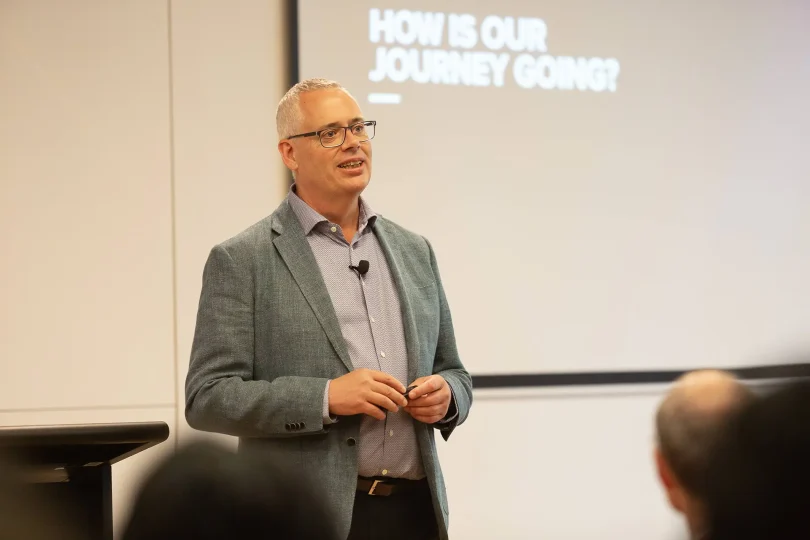We recently hosted a client event, Future-proof Your ERP Transformation Programs, featuring insights from Andrew McPherson (SkyCity) and Toni Warren (Mercury NZ & Testify). The panel explored critical ERP topics including AI, testing, project management, and financial governance. Through real-world examples and audience questions, the session offered practical strategies for overcoming challenges, managing complexity, and ensuring successful ERP outcomes in today’s fast-evolving digital landscape.
To download a copy of the transcript, please click here.
To watch the recording of the panel discussion, please click here.
Below is the list of questions raised during the panel discussion:
Q1) [0:02:09:23] Can you share a specific example from your experience where an ERP transformation program faced unexpected challenges or setbacks?
How did you overcome those obstacles, and what lessons did you learn from that experience?
Q2) [0:08:51:00] In the context of ERP transformation, data migration is often a significant challenge. So, could you provide examples or an example of how data quality practices have impacted the success of your projects?
Q3) [0:12:53:17] In the world of ERP, customisation is often a double-edged sword. How do you strike the balance between tailoring your ERP system to meet specific business needs and keeping the software manageable and upgradeable in the long run?
Q4) [0:18:24:15] What specific AI tools can organisations use to enable more efficient workflows?
Q5) [0:22:14:23] So, ensuring alignment of user needs, staying within budget and adhering to timelines are essential goals in ERP transformations. So, could you share any strategies or best practices for achieving this delicate balance, particularly when unexpected changes or user requirements emerge during the project? Plan for the worst and hope for the best.
Q6) [0:28:01:14] So, how can organisations balance the need for continuous innovation and delivery with the need to reduce the Total Cost of Ownership and mitigate project risks? Test automation, test automation.
Q7) [0:32:07:13] I’m really interested in the end user – the customer. I’m just wondering what has worked for you guys in the past, what approaches you’ve taken to really testing the experience of the end user.
Q8) [0:36:58:00] What’s the balance between 1) manual versus automation testing 2) business versus dedicated QA doing the testing. And who maintains automated testing post-go-live?
Q9) [0:39:06:10] Testing in parallel to development could be easy to implement in a new project, but in an ongoing project where testing is a catching-up task, how can we correct things?
Q10) [0:41:39:06] How do you balance focus between the happy path and edge cases when edge cases may represent less than 1% of instances and similarly small revenue impact?
Q11) [0:44:43:18] In terms of data migration, how important is it to ensure your existing data is cleaned, and how much effort, resources and time is needed?
Q12) [0:46:21:14] In Andrew’s view, having being a CIO is his advice that business bends to platform rather than vice versa? Other CXOs might be very reluctant, especially CX/UX related.
Q13) [0:48:37:03] In hindsight, what are the questions you wish you had asked before choosing your system and/or vendor?
Q14) [0:49:44:21] Can Agile principles be applied to test earlier in ERP transformations and de-risk end phases that are closer to critical milestones like go live.
Q15) [0:51:56:12] Can Toni clarify if she means 30% of the ERP implementation budget should be for testing, or does the contingency need to be 30% of the test budget?
Q16) [0:52:34:13] Andrew, who should be on the hook to write the test cases if this is done ahead or in parallel with development?
Q17) [0:51:56:12] Can Toni define what she means by defect rate and what is a good benchmark?
Q18) [0:55:47:09] When in the journey, do you involve business uses? Some of the examples where issues have been identified, sound like it was too late? Was it waterfall?
Q19) [0:57:10:16] Thin slices can only be achieved if the foundation is there. How do you balance getting foundation in and convincing stakeholders about vertical slicing with the business?
Q20) [0:58:52:20] Do you have any examples of where there was a challenging stakeholder that was not engaged in the ERP transition and how that was overcome?
Q21) [1:01:01:04] How are ERP transformations being done today, Agile vs Waterfall.
Q22) [1:03:24:18] Last question, just to wrap up with a quick-fire question. if you have one piece of advice to give people embarking on digital transformation, what would that be?



